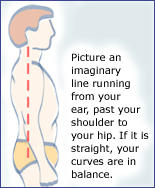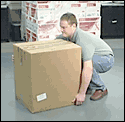| Put An End To Back Pain
 |
|
Sit up straight! Sound familiar? Maybe our parents and teachers knew more about preventing back injuries than we might have suspected.
About eighty percent of Americans experience back pain at some point in their lives, according to the American Academy of Orthopedic Surgeons. Once you have had a back problem, your chance of injuring your back again is greater than if you had never experienced back problems.
Activities such as lifting heavy boxes and moving furniture are often tagged as the chief back breakers. But these one-time, isolated activities, although painful, are not the primary offenders. At the root of most back injuries is a history of poor posture. Improper posture makes everyday activities like sitting, standing and walking high-risk endeavors.
By making a few adjustments to your posture and incorporating a moderate exercise program, you can prevent most back injuries from happening or from recurring.
|
 |
|
|
 |
A healthy back has three natural curves: the cervical (neck), thoracic (chest) and lumbar (lower back). Your muscles and ligaments work most effectively when the curves of your back are aligned with one another, minimizing the stress placed on your spine. Try to visualize an imaginary line running from your ear, past your shoulder to your hip. If your back is in proper alignment, the line should be straight.
Below are some basic terms you should know:
Bones in your spinal column are called vertebrae. A healthy spine is made up of 24 vertebrae. The vertebrae provide the framework for your back and protect your spinal nerves.
Discs act as the body's shock absorbers and allow the body to move. Discs are located between each of the vertebra.
Muscles provide support for the spinal structure. They help you keep your back upright and maintain the three natural curves of your back.
Ligaments bind bones or other body parts together. They prevent excessive motion and support the body.
Back To Top
Here are some guidelines to help you maintain the three curves of your back during everyday activities.
Note: Always consult your physician first before beginning any exercise program.
Sitting is not a form of rest for your back. Sitting increases the stress placed on your back, and a slouched position will add even more stress. No matter what kind of chair you sit on, some minor adjustments can make sitting less stressful on your back.
Place a pillow or rolled-up towel in the small of your back to support your lumbar curve. This is important if your chair has a straight back. You can use a lumbar pillow or rolled towel while sitting on a dining room chair, airplane, movie theater or car seat.
Sit with your spine and buttocks flush against the back of your chair. Your feet should be flat on the floor to take some of the weight off your thighs. Your hips should not be lower than your knees.
Place your feet on a stool, book or box if they do not touch the floor.
Take a good look at your chair to see what adjustments you can make for more comfort.
Pull your chair in as close as possible to your desk or table to prevent you from bending forward.
Alter your position frequently to give your back a break.
Use the arm rests for support when standing up. If your chair doesn't have arm rests, place your hands on the desk or table in front of you to help lift yourself. If you must sit for more than one hour, try to do some easy stretching exercises. Here's one that can help relieve tension in your middle back that results from sitting for long periods:
Move your chair away from your desk so you have room to stretch. Interlock your fingers, turn your palms outward and extend your arms away from your body as far as you can. Keeping your back straight and arms parallel to the desktop, turn your shoulders to the right and return to the center. Turn your shoulders to the left, and then return to the center.
 |
|
Image illustrates ideal sitting posture. Back is flush against the chair. Feet are flat on the floor.
|
|
Standing for a long period of time is difficult for the back and can cause soreness and fatigue. If you find yourself standing over a bench or desktop or even doing simple household chores such as ironing or vacuuming for long periods of time, try these tips to make your back feel less strained.
Stand close to your task.
Elevate one foot on a stool or box to reduce the stress placed on your back.
Change your position frequently.
Look straight ahead when walking instead of at your feet. Visualize an imaginary string attached from your chest to the ceiling pulling you along as you walk.
 |
|
Image illustrates ideal standing posture. One foot is elevated to reduce stress on the back.
|
|
Improper
bending and lifting
can cause back injuries as well. Follow these simple guidelines the next time you find yourself doing some heavy-duty lifting.
Lift only what is comfortable for you.
Check the pathway you are traveling. Make sure there is nothing in your way to avoid tripping or slipping.
Always face the object you are lifting.
When lifting light objects, place one leg in front of the other, shoulder width apart, and bend down at the knees. Avoid twisting your torso while lifting, and use your leg muscles to lift instead of your back.
Before lifting heavy objects, stop and evaluate the load to make sure it's light enough for you to carry alone. If in doubt, get help.
Stand as close to the object as possible, placing one foot beside the object and lowering your other knee to the floor. Grasp the object firmly, roll it onto your lower thigh and lift the object onto your opposite thigh. Bring it close to your body and stand, keeping your head and shoulders upright.
For tasks that require bending forward, such as vacuuming or raking, try to limit the distance you reach. Move your whole body, not just your arms.
 |
|
Image illustrates ideal lifting posture. Knees are bent, object is close to the body, head and shoulders are upright.
|
|
Lying down takes pressure off of your discs. The discs are then able to draw nutrients from the surrounding tissues of the body by the process of osmosis. This is the primary method of nutrition for the disc. Therefore, it is important to give some thought to what type of mattress you sleep on. Remember to:
Choose a mattress that has firm support but is soft enough to accommodate the normal curves of your back.
Try to sleep on your side with your knees bent slightly upward and forward to your chest.
If you sleep on your back, place a rolled towel or pillow under your knees to relieve back tension. Try to avoid sleeping on your stomach, which forces your back out of its three curves. Choose a pillow that is not very full.
Back To Top
Maintaining proper posture throughout your day is only part of the solution. Regular exercise can be the difference between a sore back that is vulnerable to injury and a strong back that is ready to take on the day. Back pain often results from weak abdominal muscles and tight hamstring (back of thigh) muscles. Strong muscles help support the back and flexible muscles allow the body to move. Even something as minimul as a 15-minute routine can help you condition the muscles and joints.
Note: Always consult your physician first before beginning any exercise program.
By making a few adjustments to your posture and incorporating a moderate exercise program, you can prevent most back injuries from happening or from recurring.
Take the Back Quiz.
Back To Top
|